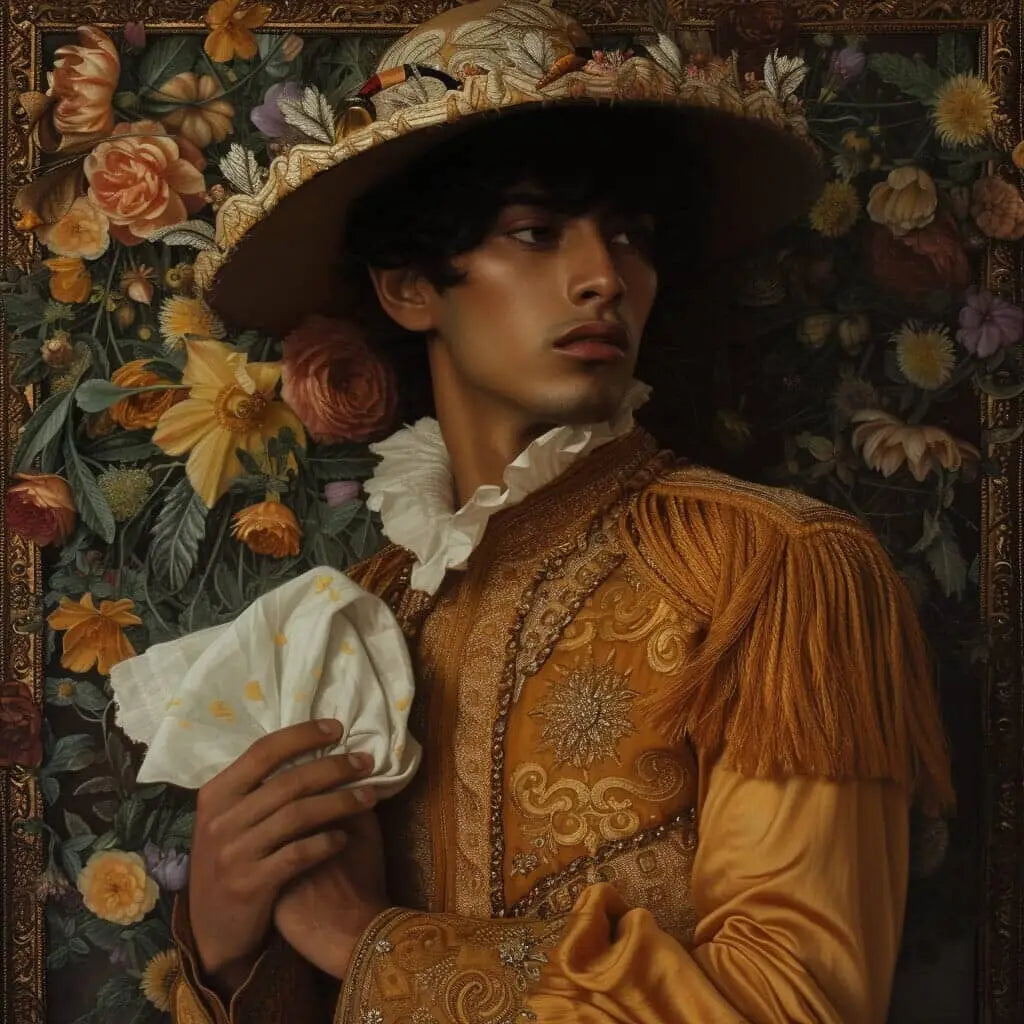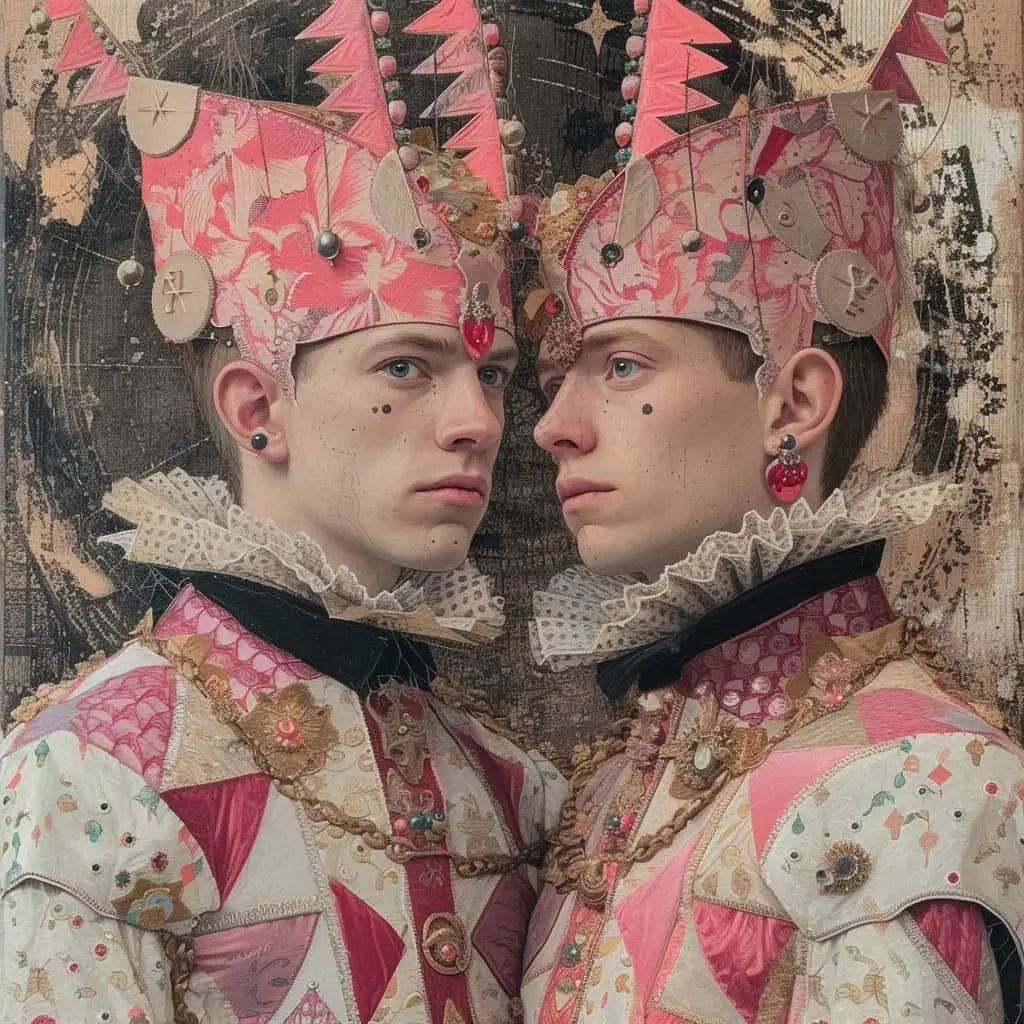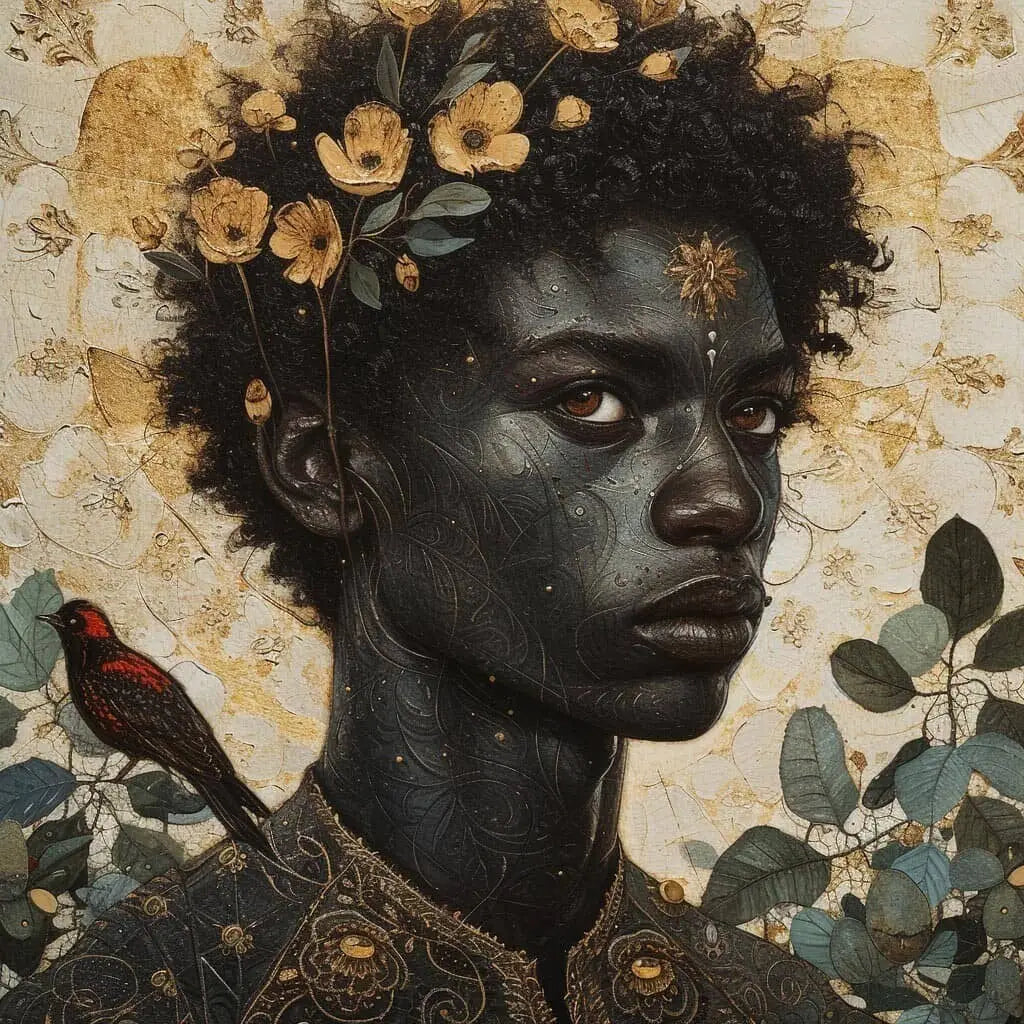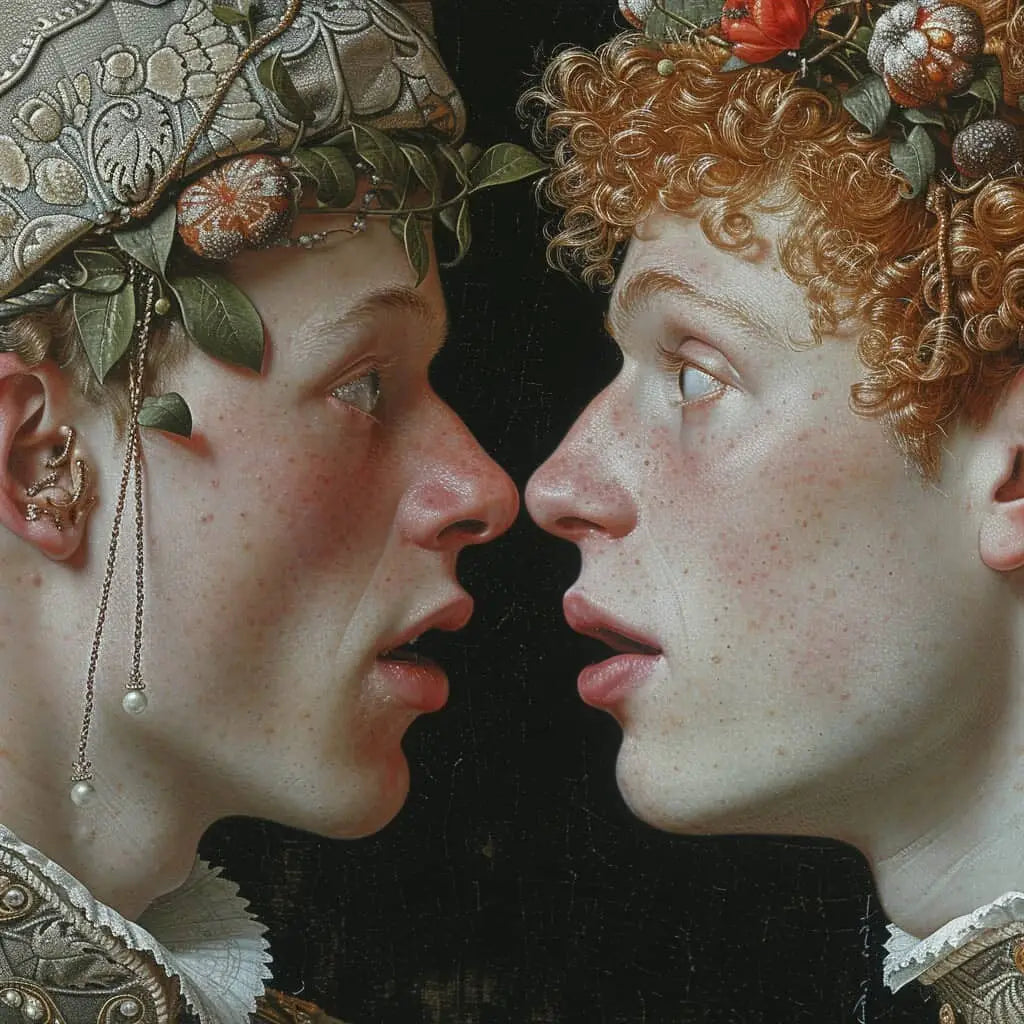艺术史,文化和更多东西的隐藏酷儿符号擅长...
艺术史上的酷儿编码的符号使创意校友在公开谈论他们的酷儿时可以分享一些他们的真实自我。仍然可以。并不是说这使奇怪的人在很伟大的时代很棒。没有什么能阻止这一点。此外,... Queers喜欢代码。集团,您可能会说。至少...他们通常很有趣。
编码 视觉语言很重要 同性恋 历史上的艺术。但是,我们要研究的所有酷儿编码符号都集中在过去的几百年中。为什么?概念 性身份是一项相对较新的发明,其历史可以追溯到十九世纪后期,并与现代科学和医学的形成有关。最值得注意的是,在现代背景下,由于同性恋行为和 与同性恋相关的社会污名.
现在让我们继续 并探索一大堆在一般的艺术,历史和文化中编码的符号。每个都有自己的好奇神秘感。是自我表达,思想自由和其他象征的迹象。
什么是酷儿艺术?甚至是其他...
出于本文的目的 酷儿 艺术 指同性恋,女同性恋,双性恋,变性者和双性恋者的艺术。 d从摄影到肖像画,抽象绘画到雕塑以及拼贴和混合媒体混乱的顺序。
要揭露它,要让它在露天中呼吸,必须 更深入地了解艺术创作的历史,揭露了被历史的重量和偏见的痛苦所掩盖的隐藏宝石。和eACH新媒介(每一种风格的转变)提供了一个新的机会,可以探索身份的深度,以抵抗我们短暂生活的美丽,不可预测的本质。
回到好消息:(大多数)酷儿艺术家对我们被缝制的破旧刻板印象没有该死。在历史上进行的许多酷儿艺术的例子已经展示了如何学习规则,以便您可以打破规则。重塑它们。创造新鲜,活着和自由的东西。酷儿艺术家几乎一直是叛军,先驱者,那些盯着世界的人说:“不,不像那样。这样。”这样,他们 发声声音。对于那些拒绝沉默的人来说,一种视觉语言。 这就是为什么酷儿 艺术仍然是捕捉同性恋的有力的政治和庆祝方式,女同性恋,双性恋,变性者和双性恋者的生活经历。
1
绿色康乃馨

绿色康乃馨变成了 酷儿身份的流行象征 什么时候 奥斯卡·王尔德 指示他的朋友将它们戴在翻领上 1892年首映他的戏剧《温德米尔夫人的粉丝》。绿色康乃馨成为酷儿自豪的象征,是王尔德和他的圈子的一种方式 谨慎识别.
绿色康乃馨也与 审美的 运动,哪个 为艺术而著名的美和艺术。花体现了decade废,不自然和艺术. 有些人甚至说这些“不自然”的绿色康乃馨,眨眨眼和微笑,是同性恋者在维多利亚时代的尖锐鼻子上大拇指鼻子的一种狡猾方式。一种秘密语言。隐藏在视线中的大胆声明。一阵色彩和叛乱,大胆地违抗将自己的爱(和欲望)在阴影中的世界。当他们穿着绿色康乃馨时,他们为自己雕刻了一个空间,无论颜色或形式如何.
当今,许多组织仍然使用绿色康乃馨的名称或肖像学。
酷儿编码的绿色康乃馨
文学中的绿色康乃馨- 罗伯特·希钦斯(Robert Hichens)的“绿色康乃馨”:这部小说于1894年首次匿名出版,是对美学运动当代冠军的讽刺。第二年奥斯卡·王尔德(Oscar Wilde)审判丑闻后,它被短暂撤回.
- “绿色康乃馨:同性恋经典盒装套装”:这个系列庆祝王尔德和过去代表同性恋爱与欲望的其他作者。该集合包括 多里安·灰色的图片, 约瑟夫和他的朋友, 塞西尔·德雷姆(Cecil Dreeme), 平原城市的罪过, 和别的.
- “理想丈夫”(1999):在这部电影中,亚瑟(Arthur)选择纽扣孔的绿色康乃馨是对奥斯卡·王尔德(Oscar Wilde)的微妙敬意。王尔德(Wilde)和他的同性恋朋友的“内心圈子”曾经穿绿色康乃馨,以谨慎地展示自己的性行为.
- 盖伊·马丁(Guy Maddin)的“绿色雾”:好的...没有绿色康乃馨,但是这部实验纪录片通过同性恋文化历史的雾气,点头了酷儿编码的花.
其他已成为酷儿符号的花
其他被用作酷儿身份象征的花朵包括紫罗兰,这是自6世纪以来与女同性恋相关的紫罗兰 希腊诗人 Sappho 从岛上 Lesbos。在20世纪初期,在“潘茜热潮“。“ Pansy”一词被用作同性恋或跨性别的诽谤,但此后,许多激进主义者和艺术家都拥有该术语的所有权并改变了其贬义的含义。
酷儿艺术家经常使用花朵来象征着美丽,性感和庆祝差异,超越时间和地点。因此,毫不奇怪的是,花朵一直是酷儿艺术中的反复出现的主题。来自Karl van Vechten的 哈林居民的摄影 在1930年代和40年代,罗伯特·麦普雷索普(Robert Mapplethorpe) 黑白花摄影.
2
孔雀羽毛

孔雀羽毛用作酷儿身份的象征 19世纪末和20世纪初. 在维多利亚时代的审美运动中,时尚的符号是当天有趣的语言。 鲜花,手帕和粉丝表演 就像一个灰色世界中的秘密特工一样。庆祝自我表达和联系。帮助男人和女人在最出乎意料的地方找到喜悦和友情。
雄性孔雀的华丽尾羽被视为表现出非构型美的代表。 m恩会戴孔雀羽毛,以将自己识别为其他同性恋男人,而艺术家将羽毛纳入艺术品中,作为一种微妙的方式来信号。在周围 借助奥斯卡·王尔德(Oscar Wilde),与绿色康乃馨同时是同性恋男性身份的流行象征。
雄性孔雀的华丽和奢华的外观比雌性Peahen的外观更为惊人,这也使孔雀羽毛与酷儿身份相关。
酷儿编码的孔雀羽毛
埃德蒙·杜拉克(Edmund Dulac)的画作中,孔雀羽毛被用作酷儿符号的一个例子”查尔斯·里基茨(Charles Ricketts)和查尔斯·香农(Charles Shannon)”(1920年)。在这幅画中,查尔斯·香农(Charles Shannon)被描绘成孔雀羽毛,并将宗教意象与奇特身份的象征并列。 精湛的构图不仅捕捉了眼睛,而且还邀请观察者探索意义上的层面,因为绘画成为公开和秘密之间的视觉对话。
3
Hanky代码

这 男同性男性汉基密码,或标记,就像一个秘密握手。对于那些知道的人来说,鲜艳的眨眼和轻推。 Hanky代码涉及在口袋中戴不同颜色的头巾,以指示不同的扭结,性偏好和角色,例如上/DOM或底部/底部/顺从。
Hanky代码 起源于 旧金山 在1970年代,在同性恋者中,佩戴彩色头巾作为实用配件很常见。在同性恋被认为和犯罪时,同性恋者以谨慎和非语言的方式传达他们的性偏好和欲望,从而对同性恋文化的历史产生重大影响。
只是一丝面料,一点点颜色藏起来了,突然之间,您正在讲一个整个故事,例如欲望的步行广告牌。一种巧妙的聊天方式,而无需说一句话,建立联系并在生活的漩涡混乱中找到您的部落。
《汉克法典》还帮助在同性恋者中建立了一种社区意识和归属感,他们可以识别和共享相似兴趣和欲望的人并建立联系。此后,《汉克代码》(Hanky Code)进行了复兴,今天仍在某些LGBTQ+社区中使用,尽管特别使用手帕的使用可能并不像以前那样普遍。
酷儿艺术和文化中的汉克密码
艺术中的汉基代码
- 哈尔·菲舍尔(Hal Fischer)的“同性恋符号学”:描绘了塞在同性恋者后口袋中的手帕中每种颜色的含义。他的作品在迭代和今天的展览中被回收,引用和重新发行.
- 酷儿生态学项目:涉及125多位设计,印刷和分发头巾作为可穿戴艺术品的艺术家。该项目扩展了原始同性恋代码的定义以包括 不同的身体,身份和活动.
- 布拉德·盖伊:创建了一个有关汉克代码的照片系列教学,并对酷儿文化的这一独特方面进行了视觉探索。
Hanky代码指南
- 是的,我在标记:酷儿标记101 作者:阿奇·邦戈瓦尼(Archie Bongiovanni):这张插图的杂志是关于我们对一些休闲NSFW乐趣的非语言方式。它包括标记的历史和各种阴影之间的细微差别.
电影中的汉基密码
- “ Hanky Code:电影” (2015年):这是一部史诗选集故事片,结合了25个短裤 不同的酷儿导演 在全球范围内,每个讲述一个基于颜色/恋物癖的故事 臭名昭著的Hanky代码.
4
粉红色的三角形

粉红色的三角形 从阴影开始 - 纳粹最初在集中营中使用,以识别和羞辱同性恋者. 男同性恋者被迫在胸部口袋上穿粉红色的三角形,以使他们与其他囚犯区分开来,并使他们遭受其他囚犯的进一步迫害和暴力。粉红色的三角形是 作为武器。
当战争结束时,集中营大门被打开,苦乐参半的时刻展现出来。大多数囚犯被释放,拥抱重建生活的机会。然而,对于装饰有粉红色三角形的男同性恋囚犯,他们的旅程还没有结束。
这些人仍然带有他们所感知的差异的痕迹,被送回阴影,返回监狱并面临持续的迫害。一个清醒的提醒,尽管世界可能会改变,但接受和理解的道路一直是一条漫长而曲折的道路,充满了挑战。
最终,粉红色的三角形进入了光线。随着LGBTQ+社区的收回, 将其变成希望和自豪感。 b1980年代和90年代艾滋病流行期间生与死的象征。用作LGBTQ+骄傲的普遍象征,以及国际弹性和对正义要求的国际宣言。一种变形,证明将疼痛转化为胜利的力量。
粉红色的三角形已在全球的LGBTQ+权利示范中使用。这提醒人们过去对LGBTQ+人的暴行,并象征着为世界各地争取平等和接受的斗争。
酷儿艺术和文化中的粉红色三角
文学中的粉红色三角
- "粉红色三角的人“亨氏海格(Heinz Heger)生动地说明了纳粹集中营对同性恋者的迫害.
- "由粉红色三角“肯·塞特灵顿(Ken Setterington)也探索了这一历史以及粉红色三角形转变为同性恋权利的象征。
电影中的粉红色三角
艺术和图形设计中的粉红色三角
- 激进主义者的艺术家 小组表演 在1980年代采用粉红色三角形作为全球艾滋病活动的强大徽标.
5
古典和神话认同

整个历史上的酷儿艺术家 已经采用了编码的视觉语言,不会在公众中引起人们的怀疑,但会允许那些熟悉亚文化的比喻的人,可以收集隐藏的含义。在昔日的日子里,酷儿爱的整个想法与我们现在看到的方式完全不同。因此,众神和女神和介于两者之间的每一个神都不会想到这样的性别。只要看所有 希腊和罗马神话中的古怪。从昔日的日子开始,还有更多的酷儿传说。哦是的。和文化 全球aaaaaaall.
尽管如此,尽管在世界各地的几乎每种文化中都有一段奇怪的事物……时代发生了变化。当奇怪的人再也无法公开表达自己的爱时,他们找到了聪明的方法来说出他们的意思而没有明确揭示。。掩饰自己的激情,例如古老的,令人着迷的希腊神话故事. 弗雷德里克·莱顿(Frederick Leighton) “daedalus和icarus”是一个明显的例子 - 暗示了老年导师和年轻人之间的性关系 古希腊.
奥运会众神升起各种各样的酷儿恶作剧,他们在西方佳能中的地位已获得艺术家的许可,可以通过这些数字将自己的欲望与社会可接受的对比联系起来。 A 在社会规范边缘跳舞时倾泻他们的心。允许当时的酷儿观众通过工作找到含义和联系。
艺术和文化的古典酷儿
古代文化和古典神话
- 阿波罗和风信子:在希腊神话中,太阳与音乐之神阿波罗与一个名叫Hyacinthus的英俊青年建立了浪漫的关系。他们的故事是一个悲惨的故事,因为风信子因阿波罗(Apollo)扔了一场铁饼而死亡,这是嫉妒的风神Zephyrus吹牛的路线.
- 阿喀琉斯和patoclus:荷马的伊利亚特(Iliad)描绘了阿喀琉斯和帕特洛克斯(Patroclus)之间的深厚,亲密的纽带。尽管他们关系的本质可能会受到解释,但许多人认为这是同性爱的代表.
- 哈德良和安提米:罗马皇帝哈德良对希腊青年安提斯的热爱,有据可查。在安提内斯(Antinous)过早死亡之后,哈德良(Hadrian)脱颖而出,他的形象在整个帝国中被广泛传播。
- 大胆的玛雅神下巴 向玛雅文化介绍了同性恋,引发了同性爱的火焰。他大胆的例子启发了贵族家庭将儿子与其他年轻人搭配,形成了婚姻关系。
- 在因纽特神话中,前两个人是Aakulujjuusi和Uumarnituq,两个人。他们陷入了爱情和魔法的转折中,乌马尼图克(Uumarnituq)转变并带有孩子。一个出生的孩子也带来了战争艺术。在如此伟大的爱使不可能的,成为可能的伟大的魔力。但仍然……战争。这不是很有意义的,而是……世界上所有的意义。而且,您一定会喜欢从罗马到西北北极的神灵。他们按照自己的规则进行演奏,就像我们大多数酷儿今天所做的那样。
经典文学中的酷儿
- 奥斯卡·王尔德(Oscar Wilde)的《多利安·格雷的图片》:虽然不是公开的同性恋,但小说充满了同性恋潜台词。角色罗勒·霍尔沃德(Basil Hallward)和亨利·沃顿(Lord Henry Wotton)对多利安·格雷(Dorian Gray)的美丽表示敬佩。
- E.M. Forster的“ Maurice”: 这本小说写于1913 - 14年,但于1971年死后出版,讲述了莫里斯·霍尔(Maurice Hall)的故事,莫里斯·霍尔(Maurice Hall)在一个被污名化的社会中与他自己的同性恋者达成协议。
艺术史上的酷儿
- 米开朗基罗的十四行诗:米开朗基罗(Michelangelo)对年轻贵族托马索·迪·卡瓦里里(Tommaso Dei Cavalieri)的十四行诗,许多学者认为表达浪漫和色情爱情。
- 文艺复兴时期的艺术:一些文艺复兴时期的艺术家巧妙地将对同性恋爱的典故纳入了他们的绘画中。例如,据信莱昂纳多·达·芬奇(Leonardo da Vinci)和米开朗基罗(Michelangelo.
6
北极星:秘密语言

北极星 是一种秘密语言 这是同性恋者,拖拉皇后和更多局外人子组所说的 英国从1930年代到1960年代. 它使人们可以谨慎地互相交流,没有风险。合并n 成分的不断发展的混合 从 浪漫语言,罗马尼,科克尼押韵的语以及水手和小偷的守则。用意第绪语借来的话 和 1960年代的药物亚文化也是如此。但是它确实有 一个小的核心词典和两个主要版本:一个 科克尼 押韵语版本+一个强调戏剧和古典影响的“西端”版本.
北极星从 娱乐世界,从 西端 剧院,到19世纪的音乐厅,再到马戏团和集市展览会。因此,同性恋社区从来都不只是使用它。北极星是在伦敦鱼市场,剧院,集市和马戏团的。同性恋者在同性恋活动是非法的时候使用的同性恋者……可能也很有趣,但实际上很难验证。主观性和所有人。
Polari具有重大的文化和艺术影响,其许多术语被采用到常规的英国语中 LGBTQ语 并向下过滤成主流语。近年来,随着年轻的LGBT人们渴望学习北极星并发现自己的文化遗产,它已经看到了文艺复兴。
波利酷儿艺术和文化
北极星艺术
- 这 艺术家Zackary Petot的作品 将此法典语言与绘图,版画和数字技术结合使用,借用了现代风格。
- 该语言也已在一组名为The The的男性修女的仪式中采用 永久放纵的姐妹.
北极星文学
- "Fabulosa!:Polari的故事,英国的秘密同性恋语言“保罗·贝克(Paul Baker)撰写了对polarri的语言起源,其用法以及1967年后时尚的使用方式进行深入的探索。
- "Polari-同性恋者的失落语言“保罗·贝克(Paul Baker)也深入研究了北极星的历史和使用。
电影中的北极星
- 在2015年短片中”穿盘子”,两个男人在公园长凳上进行了谈话 生活,性别和敌对世界 他们发现自己是同性恋男人,完全在帕尔里讲话.
- 1998年的电影“天鹅绒金矿“也是特征 两个角色讲polari 在伦敦夜总会。
—
结论:同性恋象征主义的开拓性艺术
艺术中隐藏的酷儿符号的历史证明了 LGBTQ+ 艺术家的韧性和创造力。通过使用视觉代码、秘密语言和对图像的重新挪用,这些艺术家尽管面临挑战,仍设法表达自己的身份和愿望。如今,随着酷儿艺术的不断发展,认识和庆祝这些为后代铺平道路的开拓性艺术家的贡献非常重要。
•


